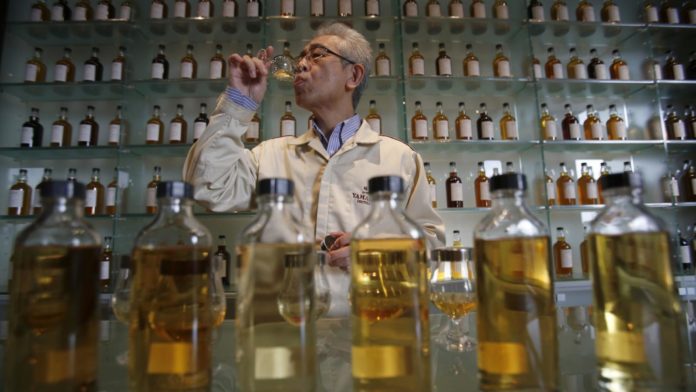The popularity of Japanese whiskey is soaring in the US. In 2010, the US imported about $1 million worth of whiskey from Japan. That rose to $50 million in 2019. It is a trend that doesn’t look likely to stop any time soon. A decade from now Japan might rival the UK, Ireland, and Canada in providing the US its most popular liquor.
It’s been a long time coming. The Japanese have made great whiskey for almost a century.
The story of Japanese whiskey is, in large part, the biography of Masataka Taketsuru. In 1918, before Japan had any experience of distilling whiskey, the Osaka-based distiller Settsu Shuzo sent the 24-year-old Taketsuru to Scotland to learn how to make it. Taketsuru, who had studied fermentation in Japan, enrolled at the University of Scotland to study organic chemistry. He went on to apprentice at several Scottish distilleries and returned to Japan in 1920, with a master’s knowledge of Scotch and a Scottish wife, Rita Cowan. (The full story is beautifully recounted in the spirits-focused magazine Chilled.)
Shuzo didn’t end up making whiskey due to financial troubles, so Taketsuru joined another distiller. That distiller would become Suntory, now Japan’s most well-known whiskey brand. Taketsuru left Suntory after a decade to start up his own distillery, which would be later be named Nikka. It is now Suntory’s top rival.
Due to Taketsuru’s influence, the techniques to make Japanese whiskey are very similar to those used to make Scotch—the processes for distilling Irish and American whiskey, for examples, are distinct from how it is done in Scotland. Although sharing many characteristics with Scotch, Japanese whiskey has come to be known for its consistency, clean taste, and thoughtful blending.
A representative from Suntory told Quartz they believed the increase was a result of two important events. In 2013, Suntory acquired Beam Inc., the owner of popular whiskey brands Jim Beam and Maker’s Mark, for $16 billion. The acquisition expanded Suntory’s distribution network globally, making it easier to meet the US market’s demands.
Then in 2014, Suntory’s Yamazaki Sherry Cask was named the best whiskey in the world by influential whiskey reviewer Jim Murray. It was the first time Murray recognized a Japanese whiskey, and Suntory believes this gained the world’s attention and boosted overseas demand.
Japan’s whiskey exports have risen across the globe. Not including those to the US, worldwide they surged from $50 million in 2014 to $130 million in 2019, according to data from the International Trade Centre.
“I was surprised by how rapidly it took off [in the US],” says Clay Risen, the author of American Whisky, Bourbon & Rye: A Guide to the Nation’s Favorite Spirit. “It went from no one had it because no one wanted it to no one has it because everyone wants it. There isn’t enough of it to go around.”
Risen thinks the recent jump has been, at least in part, a result of the beliefs Americans have about Japanese products. Following the surge in popularity of American bourbon, consumers looking for variety have turned to Japanese whiskey rather than Scotch, because it seems less fusty, and more cutting edge.
“For Americans, stuff from Japan has a certain cachet,” said Risen. “There are some, mostly deserved, assumptions about what Japanese means: It’s high quality, and it’s going to be exquisite in taste and profile, whether that’s food or whiskey.” When people do try it, they usually won’t be let down, according to Risen. A lot of Japanese whiskey is “insanely good”—he is a particular fan of whiskey from the Karuizawa distillery.
Another likely contributing factor to the rise is the massive boom in tourism to Japan over the last decade. The number of tourists to Japan has almost quadrupled since 2012, spurred by the relaxation of visa requirements to visit the country, and a fall in the value of the yen. The share of American visitors rose from less than 900,000 in 2012 to over 1.9 million in 2018. Americans traveling to Japan exposed to the country’s whiskey may come back to the US with a desire for more.
Yoko Kumano and Kayoko Akabori, the founders of Umamimart, an Oakland, California–based Japanese liquor and food store, say that it’s difficult for them to keep whiskies from Suntory and Nikka in stock because of their scarcity and popularity. “We have people call everyday looking for specific bottles,” Akabori told Quartz. When they are able to obtain bottles they usually sell out within a day. They keep other, less popular, whiskeys from distillers such as Akashi and Iwai, but they don’t sell quite as well because they lack the brand recognition.
Kumano and Akabori say there is a shortage of whiskey available for import at the moment due to the 2020 Olympics, which will be held in Tokyo. Japanese bars and stores are holding on to their bottles so they can sell them during the event, according to Umamimart’s suppliers.
The future for Japanese whiskey seems bright. The market research firm Euromonitor estimates that US retail sales of Japanese whiskey will increase from about $320 million in 2018 to $470 million in 2020. (These numbers are much higher than the import values because imports are usually wholesale costs.)
Still, even at nearly half a billion dollars, Japanese whiskey would make up less than 2% of all US whiskey sales, which Euromonitor expects to close in on $27 billion in 2020. Whiskey sales increased by over 30% from 2013 to 2018, making it not only its most popular liquor in the US, but also among the fastest growing. Japanese whiskey makers are well set to take advantage.
Dan Kopf data editor of qz.com recently published this article.







